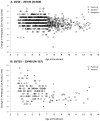Effect of age on response to amblyopia treatment in children
- PMID: 21746970
- PMCID: PMC3217111
- DOI: 10.1001/archophthalmol.2011.179
Effect of age on response to amblyopia treatment in children
Abstract
Objective: To determine whether age at initiation of treatment for amblyopia influences the response among children 3 to less than 13 years of age with unilateral amblyopia who have 20/40 to 20/400 amblyopic eye visual acuity.
Methods: A meta-analysis of individual subject data from 4 recently completed randomized amblyopia treatment trials was performed to evaluate the relationship between age and improvement in logMAR amblyopic eye visual acuity. Analyses were adjusted for baseline amblyopic eye visual acuity, spherical equivalent refractive error in the amblyopic eye, type of amblyopia, prior amblyopia treatment, study treatment, and protocol. Age was categorized (3 to <5 years, 5 to <7 years, and 7 to <13 years) because there was a nonlinear relationship between age and improvement in amblyopic eye visual acuity.
Results: Children from 7 to less than 13 years of age were significantly less responsive to treatment than were younger age groups (children from 3 to <5 years of age or children from 5 to <7 years of age) for moderate and severe amblyopia (P < .04 for all 4 comparisons). There was no difference in treatment response between children 3 to less than 5 years of age and children 5 to less than 7 years of age for moderate amblyopia (P = .67), but there was a suggestion of greater responsiveness in children 3 to less than 5 years of age compared with children 5 to less than 7 years of age for severe amblyopia (P = .09).
Conclusions: Amblyopia is more responsive to treatment among children younger than 7 years of age. Although the average treatment response is smaller in children 7 to less than 13 years of age, some children show a marked response to treatment.
Figures


References
-
- Pediatric Eye Disease Investigator Group. Randomized trial of treatment of amblyopia in children aged 7 to 17 years. Arch Ophthalmol. 2005;123(4):437–47. - PubMed

